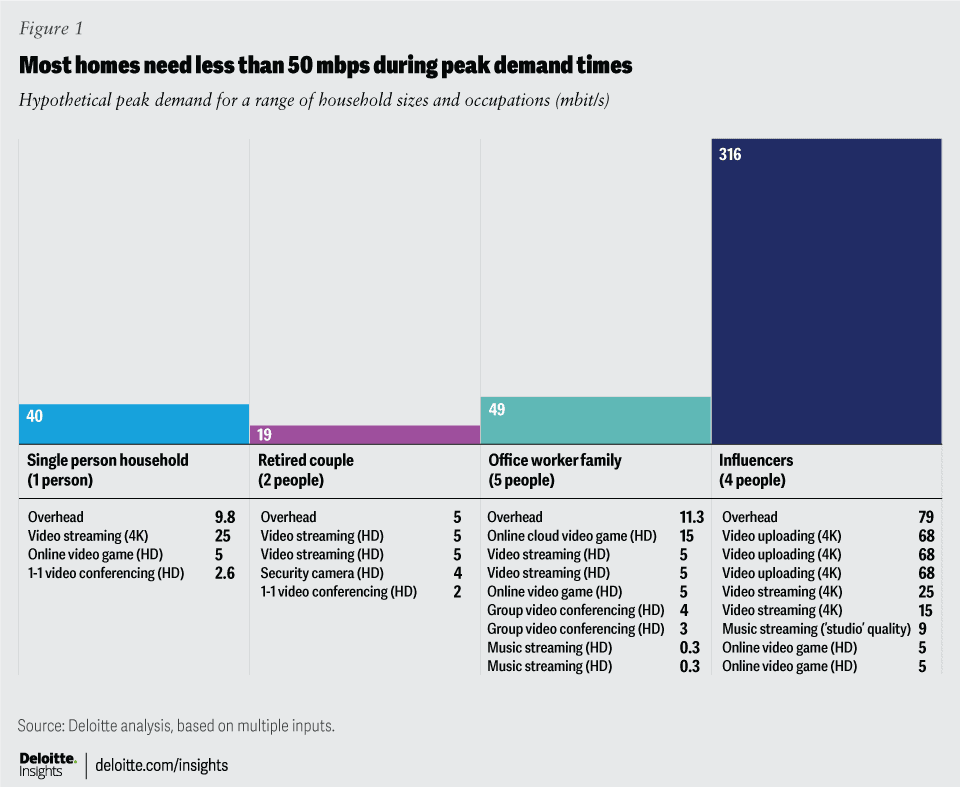The Evolution of Internet Bandwidth
Over the course of the evolution of the worldwide internet, the demand for faster bandwidth speeds on fixed networks has continued to consistently increase every year. However, contrary to what most people would think, recent changes in technology and consumer behavior indicate that this trend may be slowing down.
The surge in online video streaming has been a major driver of bandwidth demand. Yet, there are limits to this shift as well. Deloitte predicts that by 2024, more than 90% of the most commonly used online applications on fixed internet broadband networks in developed markets will have the same recommended bitrate as the year before. These applications encompass streaming video and audio, video calling, online gaming, and home security. Most of these applications provide minimum bandwidth recommendations on their websites. Deloitte’s prediction suggests that at least 80% of these applications may not see an increase in the officially recommended bitrate between 2024 and 2025. Some applications may even experience a reduction in bandwidth requirements due to improved compression technology.
Looking ahead, the aggregate peak-hour fixed broadband requirements for many households are projected to increase moderately in the near future. As a result, there may be less motivation for subscribers to proactively upgrade to significantly higher bandwidth speed packages. Instead, consumers are likely to focus more on other factors like reliability, bundled media content, and overall value.
By understanding these trends, we might be able to anticipate a shift in consumer priorities and adapt to the evolving needs of internet users.
Long-Term Infrastructure Investments
Internet service providers face various factors that drive their network infrastructure needs, extending beyond consumer demand for higher bandwidth speeds. Notably, governmental incentive programs and regulatory requirements aim to bridge the digital divide, setting minimum bandwidth speed requirements ranging from 10 Mbps to 1 Gbps download speeds. Internet service providers must build networks that meet these requirements to secure government subsidies. Moreover, competitive pressures in the market often force matching or approaching ultrafast speeds advertised by rival providers.
Considering the long-term investment nature of network infrastructure, futureproofing becomes crucial. Newer technologies not only offer greater internet speed but also improved reliability, security, sustainability, provisioning ease, lower operational costs, and reduced latency. Consequently, broadband providers are expected to transition away from aging copper digital subscriber line technologies and older cable solutions towards more advanced options, such as Data Over Cable Service Interface Specification 4.0 and fiber to the home.
Now, let’s delve into the bandwidth demand per household and the evolving composition of homes. In developed markets, the size of households has been in a long-term decline. For instance, in the European Union, the average household size in 2022 was 2.1 people, with over three-quarters of households having no children. While homes with three or more children and two parents may have high aggregate bandwidth demands, they represent less than 5% of households. Single or double-adult occupancy dominates the landscape, and by 2025, single-adult households may become the most common type.
Similar trends can be seen in the United States, where the average family household size was 2.5 in 2022. Among the remaining households, the average size drops to 1.25. Notably, 37.9 million households, accounting for 29% of the total, are occupied by a single person. By improving infrastructure and understanding evolving household dynamics, broadband providers are better positioned to meet the changing needs of consumers in the coming years.
Internet Bandwidth Demand Forecasts for 2024
- Typical Scenario
- 2-4 Person Household
- Multiplayer PC or Console Video Games
- Video Streaming Calls
- Highly Quality Streaming Music
- Smart Home Devices
- Social Media Influencers Household
- Projected Bandwidth Usage
- 50Mbps 100Mbps connection
- 5Mbps -10Mbps per session
- 4Mbps per session
- 1Mbps bandwidth
- 1Mbps – 3Mbps per device
- 300Mbps – 800Mbps connection
In 2024, for a household with 2 – 4 people, peak-time usage for the most popular applications is expected to be well below 100Mbps, even with overhead considered. A reliable 100Mbps connection would be more than sufficient to stream two high-definition (HD) videos to a television. Additionally, listening to streamed music alongside would only require an additional 1Mbps per “high quality” stream, as per the websites of popular applications.
When it comes to online multiplayer PC or console video games, a recommended bitrate of 5Mbps-10Mbps per session is most likely. As for video calls, a maximum downstream and upstream internet bandwidth requirement of 4Mbps is needed. It is worth noting that certain applications, like smart home devices, may require additional capacity, typically around 1Mbps – 3Mbps per device.
While it is an atypical example, a property with four influencers could potentially require over 300Mbps, especially if three individuals were simultaneously uploading 4K videos while downloading other content. However, households with such compositions are likely to represent less than 1% in most markets. For the more common composition of adults without children, their needs are expected to be more modest in 2024 and in the short term.
In summary, a reliable 100Mbps connection should be more than sufficient for the majority of households in the foreseeable future.
Other Popular Blog Posts
Discover more from Brander Group
Subscribe to get the latest posts sent to your email.



